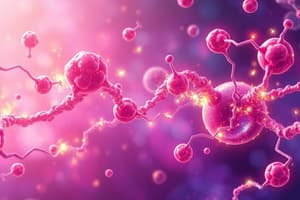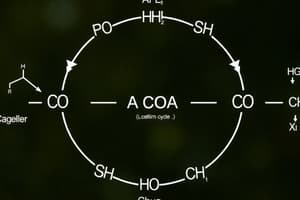Podcast
Questions and Answers
What is primarily converted by adenyl cyclase during the second messenger system?
What is primarily converted by adenyl cyclase during the second messenger system?
- GTP to GDP
- Phospholipids to fatty acids
- Cyclic AMP to AMP
- ATP to cyclic AMP (correct)
Which molecule activates protein kinase A as part of the second messenger system?
Which molecule activates protein kinase A as part of the second messenger system?
- cAMP (correct)
- G-protein
- GTP
- ATP
In smooth muscle contraction, what role does cyclic AMP play?
In smooth muscle contraction, what role does cyclic AMP play?
- It acts as a ligand for the G-protein coupled receptor.
- It directly contracts the muscle fibers.
- It activates protein kinase A to promote contraction. (correct)
- It inhibits calcium release from the sarcoplasmic reticulum.
Which component is directly linked to the G-protein coupled receptor in the signaling pathway described?
Which component is directly linked to the G-protein coupled receptor in the signaling pathway described?
What is the end product of the reaction facilitated by protein kinase A within the second messenger system?
What is the end product of the reaction facilitated by protein kinase A within the second messenger system?
What is the primary purpose of oxidation of Acetyl CoA in metabolism?
What is the primary purpose of oxidation of Acetyl CoA in metabolism?
During which stage of catabolic reactions are diverse building blocks further degraded to Acetyl CoA?
During which stage of catabolic reactions are diverse building blocks further degraded to Acetyl CoA?
What is the role of the ligand in the second messenger system?
What is the role of the ligand in the second messenger system?
What is the final common pathway in the oxidation of fuel molecules that produce Acetyl CoA?
What is the final common pathway in the oxidation of fuel molecules that produce Acetyl CoA?
Which of the following statements is true regarding adenyl cyclase?
Which of the following statements is true regarding adenyl cyclase?
Which factor is NOT involved in the activation of the second messenger system in smooth muscle contraction?
Which factor is NOT involved in the activation of the second messenger system in smooth muscle contraction?
How does the energy captured as ATP in the second stage of catabolism compare to that produced in the third stage?
How does the energy captured as ATP in the second stage of catabolism compare to that produced in the third stage?
What defines metabolism in the context of chemical reactions?
What defines metabolism in the context of chemical reactions?
Which classification best describes reactions related to the breakdown of larger molecules to generate energy?
Which classification best describes reactions related to the breakdown of larger molecules to generate energy?
What is the role of Acetyl CoA in metabolic pathways?
What is the role of Acetyl CoA in metabolic pathways?
Which factor does NOT significantly influence Basal Metabolic Rate (BMR)?
Which factor does NOT significantly influence Basal Metabolic Rate (BMR)?
What are the end products of the hydrolysis of triacylglycerols?
What are the end products of the hydrolysis of triacylglycerols?
Which process involves the breakdown of polysaccharides into simpler sugars?
Which process involves the breakdown of polysaccharides into simpler sugars?
What role do second messenger systems serve within a cell?
What role do second messenger systems serve within a cell?
Which enzyme converts ATP to cyclic AMP in the process described?
Which enzyme converts ATP to cyclic AMP in the process described?
Which receptor is primarily discussed in relation to second messenger systems?
Which receptor is primarily discussed in relation to second messenger systems?
What is the initial stage of breaking down complex molecules characterized by?
What is the initial stage of breaking down complex molecules characterized by?
What happens to glucose during hydrolysis?
What happens to glucose during hydrolysis?
In relation to second messenger systems, what does 'intracellular' refer to?
In relation to second messenger systems, what does 'intracellular' refer to?
What is the primary purpose of catabolic reactions in energy metabolism?
What is the primary purpose of catabolic reactions in energy metabolism?
Which coenzyme is typically required for oxidative catabolic pathways?
Which coenzyme is typically required for oxidative catabolic pathways?
Which statement correctly describes the difference between fermentation and cellular respiration?
Which statement correctly describes the difference between fermentation and cellular respiration?
What are anabolic reactions primarily responsible for?
What are anabolic reactions primarily responsible for?
In the context of energy generation, what occurs in the three stages of catabolism?
In the context of energy generation, what occurs in the three stages of catabolism?
Which of the following is NOT a characteristic of catabolic pathways?
Which of the following is NOT a characteristic of catabolic pathways?
What is one of the end products of fermentation carried out by yeast?
What is one of the end products of fermentation carried out by yeast?
Which of the following best describes anabolic processes?
Which of the following best describes anabolic processes?
What do anabolic reactions primarily require for their processes?
What do anabolic reactions primarily require for their processes?
How do enzymes function in chemical reactions?
How do enzymes function in chemical reactions?
What is activation energy analogous to in the given example?
What is activation energy analogous to in the given example?
What is the basal metabolic rate (BMR) primarily concerned with?
What is the basal metabolic rate (BMR) primarily concerned with?
Which electron donor is most frequently associated with anabolic reactions?
Which electron donor is most frequently associated with anabolic reactions?
Which of the following statements about catabolic reactions is true?
Which of the following statements about catabolic reactions is true?
In the context of metabolism, what is the primary role of ATP?
In the context of metabolism, what is the primary role of ATP?
What is a possible consequence of increased activation energy in a metabolic reaction?
What is a possible consequence of increased activation energy in a metabolic reaction?
Flashcards are hidden until you start studying
Study Notes
Metabolism Overview
- Metabolism is the sum of all chemical reactions in the body.
- Reactions are classified into catabolic (breaking down molecules) and anabolic (building molecules).
- Catabolic reactions produce ATP, providing energy for cellular functions.
Stages of Catabolic Reactions
- Three stages in catabolic pathways involve:
- Hydrolysis of complex molecules into building blocks (e.g., proteins to amino acids).
- Conversion of building blocks into simple intermediates like Acetyl CoA.
- Oxidation of Acetyl CoA through the TCA (tricarboxylic acid) cycle for ATP production.
Energy Generation and Usage
- Energy from the breakdown of molecules is captured as ATP.
- ATP is crucial for numerous biological functions, including muscle contraction.
- Anaerobic processes like fermentation produce less ATP and different byproducts (e.g., ethanol in yeast).
Types of Metabolic Pathways
- Catabolic pathways are primarily oxidative and release energy, often requiring coenzymes like NAD+.
- Anabolic pathways use energy to synthesize complex molecules (e.g., proteins from amino acids).
- Both pathways involve reactions facilitated by enzymes that lower activation energy.
Enzyme Action and Activation Energy
- Enzymes are protein catalysts that speed up reactions by decreasing activation energy.
- Activation energy can be likened to the effort needed to climb a hill before speeding downhill effortlessly.
Basal Metabolic Rate (BMR)
- BMR refers to the number of calories needed to maintain vital bodily functions at rest.
- It represents the minimal energy requirement for processes such as respiration and circulation.
Second Messenger Systems
- Second messenger systems help in intercellular signaling (e.g., adenyl cyclase converting ATP to cyclic AMP).
- Cyclic AMP activates protein kinase A, which is critical for regulating various physiological processes, like muscle contraction.
Importance of Coenzymes
- Coenzymes like NAD+ and NADPH are essential for carrying electrons during metabolic reactions and support energy transformation processes.
Studying That Suits You
Use AI to generate personalized quizzes and flashcards to suit your learning preferences.


